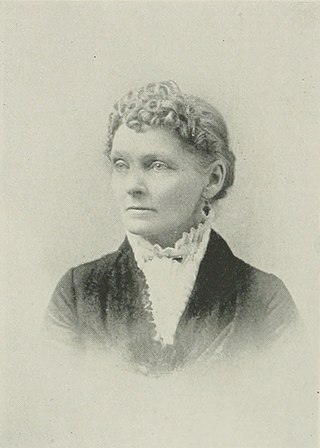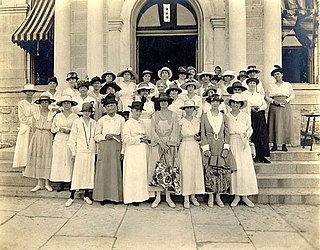Eugenia McKenzie Bacon (1853-1933) was an American suffragist and advocate for public libraries in Illinois.
Eugenia McKenzie Bacon (1853-1933) was an American suffragist and advocate for public libraries in Illinois.
Bacon née McKenzie was born on October 4, 1853, in Bowling Green, Indiana.
Bacon was a suffragist, advocating for women's rights at the Illinois state legislature. [1] She also authored suffragist pamphlets. [2] [3]
Bacon was president of the Illinois Federation of Women's Clubs (IFWC) [4] [2] and an officer of the Decatur Women's Club for ten years, five of which were as president. She then served for two terms as the State Secretary for Illinois at the General Federation of Women's Clubs. As part of her work for the IFWC Bacon was on the Library Extension Commission, working to establish public libraries in Illinois. [1] The Illinois Library Extension Commission consisted of James A. Rose, Joseph Freeman, and Bacon who served as Secretary of the Board. [4]
Bacon was also the Illinois editor for The Club Woman publication. [5]
In 1874, she married George R. Bacon (1845–1911) with whom she had one child who died at the age of eight. [1] Immediately following their wedding Eugenia and George Bacon traveled across the United States on the newly opened Central Pacific Railway to San Francisco, and then by ocean vessel to Portland Oregon by river to Camp Harney. [6] After three years Eugenia became severely ill while George Bacon was away on an expedition and returned to Illinois for medical treatment. Her husband soon resigned his army position to join her. [6]
Bacon died on December 10, 1933, in Decatur, Illinois. [1]

Dame Christabel Harriette Pankhurst was a British suffragette born in Manchester, England. A co-founder of the Women's Social and Political Union (WSPU), she directed its militant actions from exile in France from 1912 to 1913. In 1914, she supported the war against Germany. After the war, she moved to the United States, where she worked as an evangelist for the Second Adventist movement.

Adela Constantia Mary Walsh was a British-born suffragette who worked as a political organiser for the Women's Social and Political Union (WSPU) in Scotland. In 1914 she moved to Australia where she continued her activism and was co-founder of both the Communist Party of Australia and the Australia First Movement.

Rosa May Billinghurst was a British suffragette and women's rights activist. She was known popularly as the "cripple suffragette" as she campaigned in a tricycle.

Emmeline Pethick-Lawrence, Baroness Pethick-Lawrence was a British women's rights activist and suffragette.

Agnes Maude Royden, later known as Maude Royden-Shaw, was an English preacher, suffragist and campaigner for the ordination of women.

A movement to fight for women's right to vote in the United Kingdom finally succeeded through acts of Parliament in 1918 and 1928. It became a national movement in the Victorian era. Women were not explicitly banned from voting in Great Britain until the Reform Act 1832 and the Municipal Corporations Act 1835. In 1872 the fight for women's suffrage became a national movement with the formation of the National Society for Women's Suffrage and later the more influential National Union of Women's Suffrage Societies (NUWSS). As well as in England, women's suffrage movements in Wales, Scotland and other parts of the United Kingdom gained momentum. The movements shifted sentiments in favour of woman suffrage by 1906. It was at this point that the militant campaign began with the formation of the Women's Social and Political Union (WSPU).

A suffragette was a member of an activist women's organisation in the early 20th century who, under the banner "Votes for Women", fought for the right to vote in public elections in the United Kingdom. The term refers in particular to members of the British Women's Social and Political Union (WSPU), a women-only movement founded in 1903 by Emmeline Pankhurst, which engaged in direct action and civil disobedience. In 1906, a reporter writing in the Daily Mail coined the term suffragette for the WSPU, derived from suffragistα, in order to belittle the women advocating women's suffrage. The militants embraced the new name, even adopting it for use as the title of the newspaper published by the WSPU.

Julia Scurr was a British politician and suffragette.

Lucy Minnie Baldock was a British suffragette. Along with Annie Kenney, she co-founded the first branch in London of the Women's Social and Political Union.

The statue of Millicent Fawcett in Parliament Square, London, honours the British suffragist leader and social campaigner Dame Millicent Fawcett. It was made in 2018 by Gillian Wearing. Following a campaign and petition by the activist Caroline Criado Perez, the statue's creation was endorsed by both the Prime Minister of the United Kingdom, Theresa May, and the Mayor of London, Sadiq Khan. The statue, Parliament Square's first monument to a woman and also its first sculpture by a woman, was funded through the government's Centenary Fund, which marks 100 years since some women won the right to vote. The memorial was unveiled on 24 April 2018.

Belle Squire, properly Viola Belle Squire, (1870–1939) was a suffragist from Illinois who was involved in the Chicago suffrage movement and co-founded the Alpha Suffrage Club with Ida B. Wells. She was especially known for her opposition to paying taxes when women did not have a right to vote. Squire argued expecting women to pay taxes while they were not enfranchised was a form of taxation without representation.

Barbara Blackman O'Neil was an American suffrage leader in St. Louis, Missouri. She was born in 1880. Her father was George Blackman. She attended Washington University, where she studied art. O'Neil was elected the second president of the Equal Suffrage League. She later became president again following the resignation of Mrs. John L. Lowes.

Anna Amelia Churchill Wait (1837–1916) was active in the suffrage movement in Kansas. She is known for establishing an Equal Suffrage Association branch.

This is a timeline of women's suffrage in Texas. Women's suffrage was brought up in Texas at the first state constitutional convention, which began in 1868. However, there was a lack of support for the proposal at the time to enfranchise women. Women continued to fight for the right to vote in the state. In 1918, women gained the right to vote in Texas primary elections. The Texas legislature ratified the 19th amendment on June 28, 1919, becoming the ninth state and the first Southern state to ratify the amendment. While white women had secured the vote, Black women still struggled to vote in Texas. In 1944, white primaries were declared unconstitutional. Poll taxes were outlawed in 1964 and the Voting Rights Act was passed in 1965, fully enfranchising Black women voters.